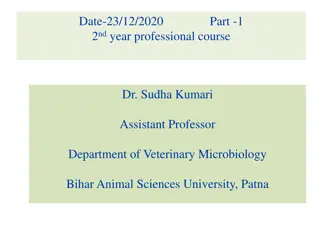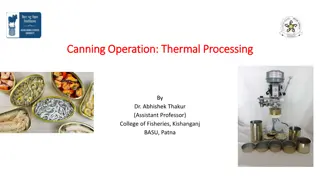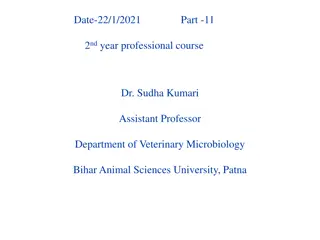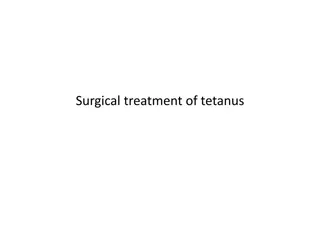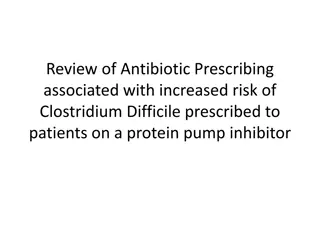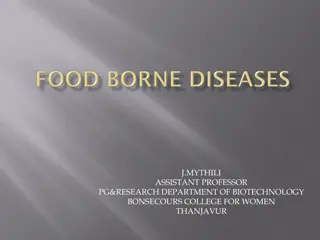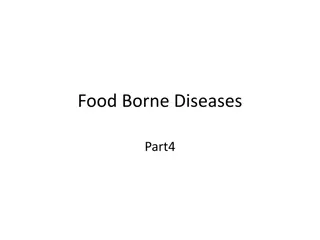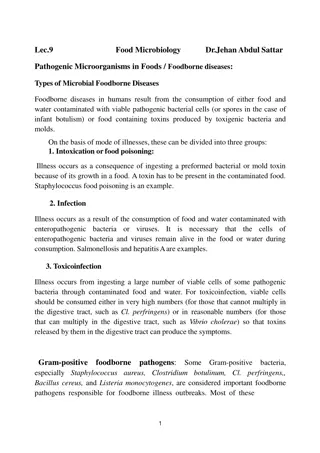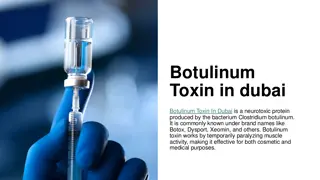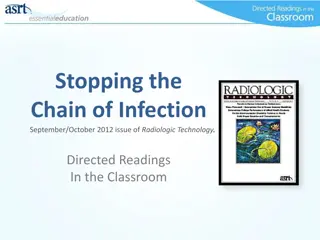Understanding Clostridium Tetani: Characteristics and Habitats
Clostridium tetani is an obligate anaerobe that forms terminal spores giving it a drumstick-like appearance. It is heat-sensitive, non-motile, and can produce toxins. Spores are found in soil and the gastrointestinal tracts of various animals. The bacterium can also be present on human skin and in c
0 views • 23 slides
Understanding Thermal Processing and Sterilization in Canning Operations
Thermal processing in canning operations involves heating sealed cans to specific time-temperature schedules to ensure consumer safety, prevent spoilage, and maintain product quality. While complete sterility is not the goal, commercial sterility is achieved to eliminate harmful microorganisms. The
1 views • 22 slides
Understanding Clostridium perfringens: Morphology, Cultural Characteristics, Toxins, and Diseases
Clostridium perfringens is a Gram-positive spore-forming bacillus found in various environments. It exhibits distinct morphological characteristics, cultural behaviors, and produces different toxins associated with diseases in humans and animals. Understanding its properties is crucial for effective
0 views • 26 slides
Overview of Clostridial Diseases Caused by Clostridium Bacteria
Clostridial diseases are caused by bacteria of the genus Clostridium, which are anaerobes commonly found in soil, feces, and healthy animal tissues. These bacteria can lead to various diseases in animals such as black quarter, gas gangrene, necrotic dermatitis, and more. Understanding the different
0 views • 55 slides
Industrial Production of Acetone and Butanol from Corn
Industrial production of acetone and butanol from corn involves a process reported by Beesch in 1953, which includes steps like using specific Clostridium species for fermentation, inoculum preparation, and recovery through distillation. The method has been essential for producing acetone and butano
0 views • 15 slides
Insights into Tyzzer's Disease: An Overview of a Bacterial Infection in Laboratory Animals
Tyzzer's disease is an acute bacterial infection affecting rodents and rabbits, caused by Clostridium piliforme. Discovered in 1917 by Ernest Tyzzer, the disease is characterized by necrotic lesions in the caecal mucosa, liver, and heart. Initially known as Bacillus piliformis, it was later renamed
2 views • 21 slides
Understanding Tetanus: Causes, Symptoms, and Diagnosis
Tetanus, also known as Locked Jaw or Saw Horse disease, is a highly fatal condition in domestic animals caused by the neurotoxin produced by Clostridium tetani. The disease is characterized by hyperaesthesia, tetany, and convulsions. Transmission occurs through contaminated soil, typically from hors
0 views • 10 slides
Buy Botox 200U Online - dermafillerstore.com
Buy Botox 200U Online is a brand name for a toxin produced by the bacterium Clostridium botulinum. Although it's best known for its cosmetic use in reducing the appearance of wrinkles, Botox is also used for various medical conditions, such as chroni
1 views • 4 slides
Common Infective Diseases in Cattle and Their Implications
Infective diseases such as blackquarter, brucellosis, and foot and mouth disease pose significant threats to cattle health and food safety. Blackquarter is a fatal disease caused by Clostridium chauvaei, while brucellosis leads to contagious abortion in cattle. Foot and mouth disease is highly conta
0 views • 17 slides
Understanding Food Poisoning and Its Causes
Food poisoning is a common threat that can be prevented with proper food handling. It is caused by various microorganisms, natural toxins, and chemical residues. The illness is characterized by rapid onset of symptoms like vomiting and diarrhea. Common bacteria causing food poisoning include Staphyl
0 views • 27 slides
Food Safety Incident Investigation: Baltimore City Illness Outbreak
Baltimore City experienced an illness outbreak linked to a lunch event, where 216 individuals fell ill after consuming contaminated food. The investigation revealed that improper handling and cooking of precooked frozen chicken led to the contamination with Clostridium perfringens. The incident unde
0 views • 40 slides
Understanding Tetanus: Causes, Symptoms, and Treatment
Tetanus, also known as lockjaw, is a bacterial infection characterized by muscle spasms that can lead to severe complications. It is caused by the bacterium Clostridium tetani, commonly found in soil, saliva, and manure. Symptoms include muscle spasms, lockjaw, and difficulty swallowing. Tetanus can
0 views • 10 slides
Antibiotic Prescribing Impact on Clostridium Difficile Risk in Patients on Protein Pump Inhibitors
Antibiotic prescribing in patients on protein pump inhibitors (PPIs) is associated with an increased risk of Clostridium difficile infection. A review was conducted on high-risk antibiotic prescriptions, revealing instances where patients were prescribed against guidelines, leading to potential comp
0 views • 5 slides
Enhanced n-Butanol Production from Lignocellulosic Biomass Hydrolysates
Biofuels production from lignocellulosic biomass offers a promising solution to replace conventional substrates. This study focuses on enhancing n-butanol production using metabolically engineered Clostridium tyrobutyricum immobilized in a fibrous-bed bioreactor. By utilizing agricultural residues l
0 views • 22 slides
Understanding Food-Borne Diseases: Causes, Symptoms, and Prevention
Food-borne diseases are caused by the ingestion of contaminated food containing microorganisms or chemicals. There are two types of food infections - contaminated food acting as a carrier of microorganisms and food serving as a culture medium for pathogens. Bacteria, viruses, and parasites are commo
0 views • 20 slides
Understanding Clostridium Perfringens Intoxication: Causes and Characteristics
Clostridium perfringens intoxication is a foodborne illness caused by the ingestion of food contaminated with enterotoxigenic strains of C. perfringens, leading to the production of Clostridium perfringens enterotoxin (CPE). This article discusses the characteristics of CPE, the origins of the organ
2 views • 23 slides
Understanding Foodborne Diseases and Pathogenic Microorganisms in Foods
Foodborne diseases in humans are caused by consuming contaminated food or water containing pathogenic microorganisms or toxins. These diseases can be categorized into intoxication, infection, and toxicoinfection, each with distinct modes of illness. Pathogens like Staphylococcus aureus, Clostridium
0 views • 5 slides
Botulinum Toxin in dubai
Botulinum toxin is a neurotoxic protein produced by the bacterium Clostridium botulinum. It is commonly known under brand names like Botox, Dysport, Xeomin, and others. Botulinum toxin works by temporarily paralyzing muscle activity, making it effect
0 views • 5 slides
Understanding Chain of Infection and Preventing Hospital-acquired Infections
Exploring the chain of infection in communicable diseases and the role of radiologic technologists in preventing transmission. Discusses hospital-acquired infections, focusing on Clostridium difficile, and highlights the importance of breaking the chain to safeguard patient health in healthcare sett
0 views • 44 slides
